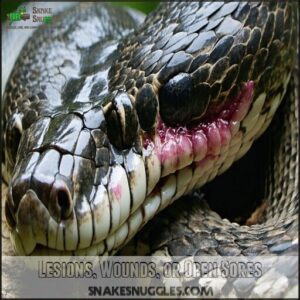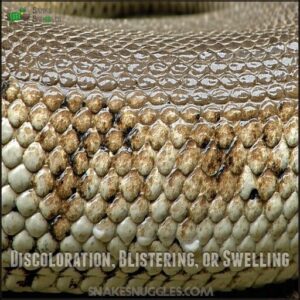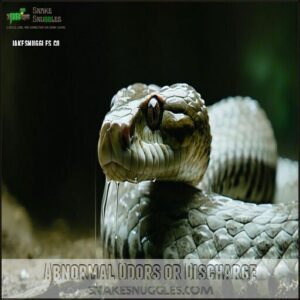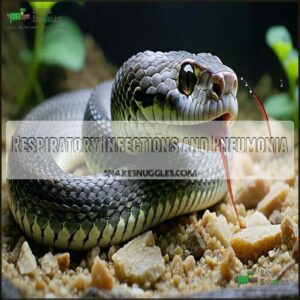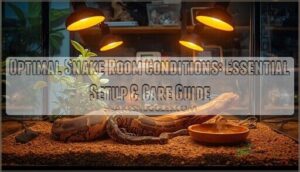This site is supported by our readers. We may earn a commission, at no cost to you, if you purchase through links.
 Noticing the signs of a sick snake early can make all the difference.
Noticing the signs of a sick snake early can make all the difference.
Watch for changes like refusing food, unusual lethargy, or odd postures. Breathing issues, like wheezing or open-mouth breathing, are red flags, while physical signs such as swollen scales, blisters, or discharge from the mouth or nose shouldn’t be ignored.
Even behavioral changes, like hiding too much or sudden aggression, can hint at illness. Think of it this way—your snake’s routine is their way of talking, and when it changes, it’s time to investigate.
A few simple checks can help pinpoint concerns and keep your slithery buddy healthy.
Table Of Contents
- Key Takeaways
- Identifying Sick Snakes
- Physical Signs of Illness
- Common Health Issues
- Behavioral Changes Indicating Illness
- Recognizing Respiratory Problems
- Frequently Asked Questions (FAQs)
- How do I tell if my snake is ill?
- What do snakes do when they are sick?
- What does an unhealthy snake look like?
- How to tell if a snake is suffering?
- How do I know if my snake is okay?
- How do you know if a snake is infected?
- What are the signs of illness in snakes?
- What are the symptoms of monkey pox?
- How do you know if a snake is ill?
- How do you know if a snake has respiratory problems?
- Conclusion
Key Takeaways
- Pay attention to changes in your snake’s appetite, activity, or hiding habits—they’re often the first signs something’s wrong.
- Watch for physical symptoms like wheezing, open-mouth breathing, unusual scale condition, or discharge, as these may indicate serious health issues.
- Keep the environment clean and maintain proper humidity and temperature to prevent common illnesses like respiratory infections and skin issues.
- Consult a vet immediately if you notice behavioral changes, abnormal postures, or signs of parasites or infections, as early treatment can make a big difference.
Identifying Sick Snakes
You can spot a sick snake by paying attention to changes in behavior, posture, and activity levels. Recognizing these signs early helps you seek veterinary care before the condition worsens.
Spot illness early by noticing changes in activity or posture—quick action can make all the difference for your snake’s health.
Changes in Appetite or Feeding Habits
When your snake skips meals, it could signal trouble.
A missed meal might seem minor, but it can hint at stress, illness, or environmental problems affecting your snake.
Watch for warning signs:
- Refusal duration exceeding normal fasting periods.
- Incorrect prey size or feeding frequency disrupting their routine.
- Regurgitation causes like stress, illness, or overfeeding.
- Snake weight loss paired with snake anorexia.
Stick to proper snake feeding guidelines, and consider appetite stimulants if the issue persists.
Altered Activity Levels or Lethargy
When your snake seems sluggish, it’s a red flag.
Lethargy or reduced movement could hint at snake illness signs like nutritional deficiencies, illness, or poor habitat conditions.
Changes in snake activity levels might stem from environmental impact or other causes of lethargy.
If weakness persists, veterinary intervention guarantees proper care to identify and address the issue efficiently, which is crucial for the snake’s health and involves proper care.
Unusual Posturing or Resting Positions
Changes in activity often accompany unusual posturing.
Watch for head tilting, spinal curvature, or "star gazing," where the snake looks upward for extended periods.
If it flips upside down or displays muscle tremors, it’s signaling trouble.
These snake illness signs often point to neurological issues.
Recognizing snake symptoms like these guarantees early detection, protecting against severe snake weakness or lethargy.
Increased Aggression or Defensiveness
If your usually docile snake suddenly acts defensive or aggressive, it mightn’t just be a mood shift—it could signal stress factors or underlying illness.
Pain response, unsuitable enclosure size, or handling issues can alter snake behavior.
Pay attention to snake symptoms like sudden strikes or excessive hissing. These snake health signs suggest contacting a vet for specialized snake veterinary care.
Lethargy can also be a sign, indicating potential underlying health issues, which may require immediate veterinary care to address the underlying illness and prevent further health issues.
Physical Signs of Illness
When your snake’s physical condition changes, it’s often a sign something’s wrong.
Watch for discoloration, swelling, lesions, or unusual discharge, as these can indicate underlying health issues that need prompt attention, particularly underlying health issues.
Lesions, Wounds, or Open Sores
Pay attention to any red, inflamed areas, open sores, or unusual lumps on your snake’s body. These signs could indicate snake skin infections, abscesses, or scale rot.
Dirty environments increase infection risk, so make certain of proper hygiene. For snake wounds, prioritize wound care by cleaning gently.
Trauma prevention, like adjusting heat lamps, reduces burns and further damage to delicate snake skin.
Scales Coming Loose or Falling Off
Loose or falling scales can signal snake skin infections, scale rot, or shedding complications.
Trauma impact and environmental factors like poor humidity or cleanliness often play a role. Inspect for infection indicators such as redness or fluid.
Maintain proper humidity and a clean enclosure to maintain snake scale health. Watch for lingering snake shedding issues or uneven scale appearance.
Regular veterinary check-ups can help with early detection.
Discoloration, Blistering, or Swelling
Discoloration, blistering, or swelling on your snake’s skin can signal illness.
Watch for:
- Scale discoloration like redness or odd patches
- Blister causes tied to high humidity or dirty enclosures
- Swelling origins from injuries or infections
- Septicemia signs, often red belly scales
- Abscess treatment needed for pus-filled lumps
These changes point to inflammation or serious skin issues.
Addressing these issues may require specialized scale care.
Abnormal Odors or Discharge
A strong, strange odor or snake discharge often signals infections or health issues.
Check for cloacal discharge, infected scent glands, or discharge from the eyes or nose.
Septicemia smell and rotting scales can also occur.
Mouth odor suggests stomatitis.
Early detection is vital.
| Symptom | Possible Cause | Location | Severity |
|---|---|---|---|
| Mouth odor | Stomatitis | Mouth | High |
| Discharge eyes/nose | Respiratory infection | Face/Head | Moderate |
| Cloacal discharge | Internal infection | Cloaca | Severe |
| Septicemia smell | Blood infection | Entire body | Critical |
The table outlines specific symptoms, their possible causes, and the affected locations, along with the severity of each condition, including septicemia smell and cloacal discharge.
Changes in Eye or Mouth Condition
A snake’s eyes and mouth can signal serious health issues. Watch for signs like retained spectacles, opaque eyes, or sunken eyes.
Discharge, swelling, or unusual snake eye appearance may also indicate infection. Mouth rot often causes redness, discharge, or swollen areas around the mouth.
Check for these issues regularly:
- Retained spectacles
- Mouth rot redness
- Discharge eyes or nose
- Opaque eyes
- Unusual swelling, which can be a sign of mouth rot.
Common Health Issues
Snakes are prone to a range of health issues, including respiratory infections, parasitic infestations, and metabolic disorders.
Recognizing these problems early is essential for ensuring your pet stays healthy and avoids serious complications.
Respiratory Infections and Pneumonia
Snake respiratory infections often show as wheezing, nasal discharge, or open-mouth breathing.
Pneumonia can worsen without immediate care, causing respiratory distress.
Humidity control is essential, as poor conditions can trigger these problems.
Watch for labored snake breathing or signs of mucus. Antibiotic options exist, but timely pneumonia treatment, adjusted husbandry, and veterinary support are key to recovery.
External Parasites and Infestations
External parasites, like mites or ticks, can wreak havoc on your snake’s health.
Frequent soaking, rough skin, and irritation are common signs. For mite identification, check water bowls or light-colored surfaces for specks.
Prevent infestations by quarantining new pets and ensuring clean enclosures. Proper scale damage treatment prevents long-term issues.
Effective snake mite control is essential for snake health. Remember, reptile parasites can pose a zoonotic risk, so act quickly to prevent long-term issues.
Internal Parasites and Worm Infestations
Unlike mites, internal parasites often stay hidden, making them harder to detect.
Asymptomatic infections can persist, but weight loss, diarrhea, or vomiting might point to snake intestinal parasites like roundworms.
Regular fecal exams and preventative care help catch issues early.
Deworming meds are effective against most worm types, but thorough cleaning prevents reinfection.
Proper hygiene guarantees healthier habitats.
Bacterial and Fungal Infections
Bacterial and fungal infections in snakes can show up as swollen scales, pus-filled sores, or unusual discoloration.
They’re often caused by poor hygiene or damp environments. Make sure to spot symptoms early to help avoid complications.
- Watch for swelling or redness along the body.
- Clean the habitat regularly to prevent infections.
- Visit a vet promptly for persistent signs or skin irritation.
Metabolic Bone Disease and Nutritional Deficiencies
Calcium deficiency and poor reptile nutrition can lead to metabolic bone disease, causing bone deformities, fragile skeletons, and muscle twitching.
Snakes typically avoid this due to whole prey diets, but improper UVB lighting or unbalanced dietary needs may increase risks.
Make certain your snake’s nutrition includes Vitamin D3 and adequate calcium to avoid this debilitating snake health issue and other reptile diseases.
Behavioral Changes Indicating Illness
When your snake starts behaving differently, it could be a sign of illness that needs attention.
Watch for changes like prolonged hiding, unusual aggression, or a lack of appetite, as these behaviors often indicate underlying health problems.
Lethargy and Loss of Appetite
Snake lethargy and anorexia are red flags often tied to illness.
A drop in snake appetite can signal underlying causes like improper dietary needs or hydration importance.
Environmental impact, such as incorrect temperatures, can worsen lethargy.
If your snake’s energy remains low or feeding habits don’t improve, seek veterinary intervention immediately to address potential snake illness signs and guarantee recovery.
Prolonged Hiding or Escape Attempts
When your snake hides excessively or tries escaping, it might signal stress or illness.
Environmental stressors, enclosure security, and snake behavior should be examined to pinpoint the issue. One major cause can be environmental factors triggering stress.
Here’s what to check:
- Is the enclosure temperature/humidity off?
- Are loud noises or vibrations nearby?
- Any noticeable snake lethargy or other illness signs?
- Should you seek veterinary consultation?
Changes in Shedding or Skin Condition
Shedding issues, like dysecdysis, often signal health problems.
Watch for retained skin patches, retained spectacles, or dull scales—these scale abnormalities reflect humidity or hydration issues.
Abnormal shedding frequency or skin infections can indicate poor care or illness.
Regularly inspect your snake’s skin appearance and address shedding problems promptly.
Proper humidity prevents these skin problems, ensuring healthy shedding cycles.
Abnormal Breathing or Respiratory Sounds
Watch out for signs like nasal discharge, mouth breathing, wheezing sounds, or a gasping posture—classic Pneumonia Symptoms in snakes.
These respiratory issues can manifest as unusual snake breathing difficulties or open-mouth breathing.
If your snake shows these symptoms or a discharge nose, seek help.
Snake respiratory infections escalate quickly, so catching these issues early is key to recovery, and it’s crucial to address them promptly to prevent further complications, which can be a matter of life and death.
Recognizing Respiratory Problems
Respiratory problems in snakes can show up as wheezing, open-mouth breathing, or nasal discharge, and these symptoms shouldn’t be ignored.
Recognizing these signs early is essential to prevent serious illnesses like pneumonia and to keep your snake healthy.
Signs and Symptoms of Respiratory Infections
Signs of snake respiratory infections include wheezing sounds, nasal discharge, and lethargy.
Open-mouth breathing and mucus buildup are common indicators, revealing snake breathing difficulties and respiratory issues.
You might notice discharge around the nose or difficulty hissing, and these symptoms often appear alongside behavioral changes, so monitor closely.
Catching snake respiratory problems early makes treatment easier and improves recovery chances.
Causes of Respiratory Issues in Snakes
Respiratory problems in snakes often begin with environmental factors or external pathogens.
Here are the main causes:
- Humidity Levels: Low or excessive humidity promotes fungal growth and infections.
- Temperature Gradients: Incorrect temperatures weaken immunity.
- Bacterial Exposure: Dirty enclosures harbor bacteria causing respiratory illnesses.
- Viral Infections: Some viruses lead to snake lung infection and nasal discharge.
Catch these issues early!
Importance of Proper Ventilation and Humidity
Humidity control and proper ventilation are non-negotiable for your snake’s respiratory health.
High humidity supports shedding success but excess dampness invites infections.
Keep reptile humidity balanced, ensuring the snake enclosure stays sanitary and fresh.
Many owners find humidity control devices useful for maintaining ideal conditions.
| Factor | Ideal Range | Risks of Imbalance | Tips for Control |
|---|---|---|---|
| Humidity (%) | 50-70 | Shedding problems, infections | Misting systems |
| Temperature (°F) | 75-90 | Infections, inactivity | Thermometer use |
| Ventilation Benefits | Moderate | Stale air issues | Screened enclosures |
| Enclosure Cleaning | Weekly | Respiratory concerns | Disinfect regularly |
The importance of maintaining the right environment is crucial, as it directly impacts the snake’s shedding success and overall health.
Proper ventilation and humidity control are key to preventing infections and ensuring the snake’s well-being.
Treatment Options for Respiratory Problems
For snake respiratory illness, treatment often involves antibiotic therapy to fight infections and nebulization treatment for direct respiratory relief.
Humidity control is essential to prevent further complications. Supportive care, like fluids and nutritional aid, boosts recovery.
Severe cases may need surgical intervention. Cultures of nasal discharge are essential for identifying pathogens.
Make certain prompt vet care is provided, as ignoring snake respiratory infections can worsen quickly, risking irreversible damage to your snake, which requires prompt treatment.
Frequently Asked Questions (FAQs)
How do I tell if my snake is ill?
If your snake seems lethargic, refuses food, or has trouble shedding, it might be sick.
Look for sunken eyes, wheezing, or open-mouth breathing.
Always consult a vet if you notice unusual behavior or symptoms.
What do snakes do when they are sick?
When under the weather, your snake might act like it’s wearing a heavy coat—sluggish, hiding more, refusing food, or showing odd movements.
Look for breathing troubles, mucus, or shedding issues, and consult a vet promptly.
What does an unhealthy snake look like?
An unhealthy snake may look thin or limp, with visible bones or sunken eyes.
You might notice dull, discolored scales, retained skin, open-mouth breathing, or bubbling from its mouth.
Early signs often include lethargy and appetite loss.
How to tell if a snake is suffering?
Spotting suffering isn’t always obvious—contrast healthy behavior with changes like lethargy, weight loss, or labored breathing.
Look for open-mouth breathing, abnormal posture, and dull scales.
If in doubt, consult a vet quickly for clarity.
How do I know if my snake is okay?
Check if your snake’s active, alert, and flicking its tongue.
Healthy snakes have smooth scales, firm bodies, and no visible bones.
Monitor eating habits, weight, and breathing; any changes might need a vet’s attention.
How do you know if a snake is infected?
Imagine your snake sluggish, refusing food, with wheezing breaths or bubbling at its mouth—these are red flags.
Look for abnormal shedding, discharge, or mites.
Always act fast with a vet’s help to diagnose infections.
What are the signs of illness in snakes?
Your snake might be ill if it shows lethargy, reduced appetite, weight loss, wheezing, open-mouth breathing, or abnormal posture.
Look for shedding issues, skin changes, or mites.
Always consult a vet for unusual behaviors.
What are the symptoms of monkey pox?
Monkeypox symptoms include fever, swollen lymph nodes, muscle aches, exhaustion, and a distinctive rash that progresses from red bumps to blisters and scabs.
You might also experience chills, headache, or respiratory issues like a cough or sore throat, which can be part of the broader spectrum of symptoms.
How do you know if a snake is ill?
About 70% of snake illnesses show symptoms like lethargy, reduced appetite, or breathing issues.
Watch for sunken eyes, weight loss, or abnormal shedding.
A healthy snake’s active, alert, and flicks its tongue often—any changes need attention.
How do you know if a snake has respiratory problems?
You’ll notice respiratory issues in your snake if it opens its mouth to breathe, wheezes, or makes clicking sounds.
Bubbling, mucus, and raised heads are also red flags.
Immediate veterinary care is critical.
Conclusion
Around 80% of snake illnesses are linked to poor husbandry, making early detection of the signs of a sick snake critical.
Paying attention to appetite, activity, and physical changes like blisters or discharge can help you spot problems fast.
Respiratory infections, parasites, or skin issues are common but manageable with quick action.
Always monitor your snake’s environment—proper humidity, temperature, and hygiene are your best allies, and trust your observations and reach out to a vet if something seems off, as early detection and quick action are crucial.
- http://www.shutterstock.com/pic-126204578/stock-photo-ball-python-python-regius.html
- https://www.myfamilypet.co.uk/corn-snake-health-problems
- https://www.petmd.com/reptile/conditions/respiratory/respiratory-infections-reptiles
- https://www.thesprucepets.com/mouth-rot-in-snakes-5181671
- https://www.merckvetmanual.com/exotic-and-laboratory-animals/reptiles/overview-of-reptiles


